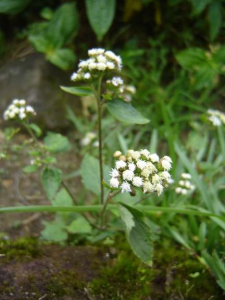Vishamushti

Vishamushti –Ageratum conyzoides
Ageratum is an annual herb that grows about 60 cm high and producer small pretty pink flower at the top of its hairy stems. In some countries it is considered an A weed that is hard to control. Ageratum ranges from southeastern north America to central America, but the center of orgin is in central America and the caribbean. Ageratum is also found in several countries in tropical and sub tropical regions, including Brazil. Ageratum is also a most common annual herb which is also common in India. In south India is grown abuntantly and is being considered as a weed. In south it is being found is a white veriety too. It is widely utilized in traditional medicine system where our it grows. It is been have much medicinal importance all over the world
Vernacular Names Of Ageratum conyzoides
Sanskrit : Vishamushti
Kannada : Helukase, naayi thulasi
Konkoni : Sahadevi
Malayalam : Muryanpacha , appa
Marati : Osaadi
Tamil : Pumppillu
Telungu : Pokabanthi
Tulu : Naayi thulasi
English : Goat weed, white weed.
Gujarati : Ajagandha
Latin : Catinga de bode.
French : Wedusan.
Indonesia : Bandotan
Jamaica : Rumpat tahi ayam
Oriya : Pokaseenga
Systematic classification
Kingdom Planatae – planets
Subkingdom Tracheobiouta – Vascular plant
Super division Spermatophyte – seed plants
Devision Magnoliophyte – flowering plants
class Magnoliopsida – Dicolyledous
Sub class Asteridae
Order Asteraless
Family Asteraceae – aster family
Genes Ageratum .L
Species conyzoids.
Family character
Ageratum in an annual herb
It is an aromatic drug.
It grows about 60 am high.
Stem – Slender, short, erect stem, branched, hairy and columnar, rough, green when fresh, Dry young stem green, pubscent, sleukes & flatteed .
Leaves – Leaves are stalked and two to three inches long and hairy both the sides, opposite, obeliotate, ovate venation is unicostate, reticulate.
Stalk – Stalks are 4 about one inch long and hairy.
Flower – Numerous, pale blue, white, pink and foul smelling.
Fruits – Fruits are minute & block.
Inflorescence – Compound coryamb
Other important member of the family
Ageratum salbia
Ageratum americana
Ageratum bovicornuta
Ageratum deserti
Ageratum gigantensis
Distribution of Habitat
Here, habitat means natural geographical range of a spices Habitation means locality where a plant is indigenous.
Their plant is basically a native of Tropical America & Caribbean .It ranges from Southeasten North American to Central America. Also found in Brazil,Africa,Java,Malaya,Phillippines,Trividad, Venizuela. In India it is found in Kerala, Karnataka , Tamilnadu, Gujarat etc.
It is being considered as weed and is hard to control.
Morphology
The plant has numerous adventitous slenter roots present in clusters growing from nodes & internodes. There are pale yellow & measures up to 15 cm long and 2.5mm thick.
Stem
Long, cylindrical, rough, hispidity hairy , they are much branched & green when fresh. Dry young stem is pale yellow, pubescent, shrunken & flattered.
Leaves
They are opposite alternative, upper region, petiolate ovate or triangular ovate.Lamina is thin more or less, hairy on both sides.Venation is unicostate, reticulate.
Flower
Numerous, pale blue, white, pink in colour. They are foul smelling.
Fruits
Fruits are minute&black.
Useful part
Root
Leaf
Whole plant
Dosage
Infusion – 1 cup twice daily
Tincture – 2.3 ml twice
Capsules – 1-2 gm twice daily.
Chemical composition
Ageratum contains many bioactive compounds including flavonoids , alkaloids, cumarins, essential oils, cheomenes, benzofurans, terpenoids, and tonics. The main plant chemical found in the plant include: 6,7-dimethoxy-2, 2- dimethyl chromene, 6-demetoxyageratocheomene, 6- vinyl-demethoxy – agreatocheomene,ageratocheomene, alpha-cubebene , alpha pinene, conyzorigin , endo bosneol , ethyl –engenol, ethyvaxillin, farnesol, friedelin, HCN , kaempferol, beta sitosteed, candinene.
Organoleptic study
Colour : Flowers are white, pink pale blue
Odour : Foul smell
Taste : Sour & bitter
Size : 3 feet
Shape : Fruits are depressed.
Properties
Rasa – Tikta, katu
Guna – Laghu, rooksha, theeksha
Veerya – Ushna
Vipaka – Katu
Dosaghna – Pittahara, vatahara, kaphahara
Pharmacotherapeutic properties & actions
Antineoplastic
Extract of the flower did not renders. Any antineoplastic activity against ascetic form of Schwartz leukaemia.
Antimicrobial
Essential oil obtained from the plant shows antibacterial activity against vibrio. Cholerae,O-gawa, shigella , shigaci.
Antihelmeathic
The essential oil of the plant exhibit antihelmeathic activity against taenia solium & pheretima pasthuma.
It also relieves pain, inflammation, reduces spasms, fever, kills bacteria, relaxes muscles, kills insects, heals wound, prevent ulces, cleanses blood, stops bleeding, stimulates digestion, reduces mucus, rheumatism, urinary infections, pneumonia, dysentery, diabetis, tumor, flu, cough.
Phamacotheraputic uses
Diarrohoea – Infusion of whole plant is given as a tonic to cure diarrohoea.
Anal prolapse – Juice of herb is given
Skin disease – A hot poultice of the leaves and stem is applied over affected part,
Wounds – Leaf juice or leaf paste for application to fresh wound for immediate cure.
Epilepsy – Squeeze the leaves with a pinch of common salt and extract the juice put 2-3 drops of juice in both nostrils once only.
Folklore uses
- A decoction of fresh plant is used as hairwash, leaving hair soft, fragment & dandruff free
- Tea made of flower head mixed with Ocinurm tenrifolium is used to treat cough & cold
- Juice of flowerhead is used externally to treat scabies, whitest a paste of them is used to treat rheumatism.
- A paste of leaf mix with Bideus pilosa, Drymaica cordata, Galinsoga parviflora and rhizome of Zingiber officinate is used to treat snake bite.
- Paste of leaf is used as poultice to remove thorn from stem
- Juice of fresh plant is also used in treating post parturn uterium haemorehage.
- Dry plant is also used in treating post partum uterium haemosehage.
- Dry plant is powered and used to cuts, sored, ruptures caused by leporasy.
Recent Reserch Advances
Laboratory research has validated several of ageratums uses in traditional medicines. Just tube studies have reported that extract of the whole plant have an antibacterial action against staphylocus aureus, bacillers sublities,eschericlchia coli, and Pseudomounas aeruginosa. In animal studies, it is demonstrated as muscle relaxing and pain relieving effect, confirming its popular use for rheumatism. In Brazil, a water extract of the whole plant war given to human patients with arthrities, 66% reported a decrease in pain and inflammation and 24 % reported an improvement in mobility after one week of treatment without side effects. Reserch in Africa confirmed its traditional uses for wound healing in animal studies in 2003.
Research in India reported that ageratum protect mice from radiation damage & prevented ulcer in mice. Both cellular protection actions were attributed, in part, to an antioxidants effect noted for ageratum.









